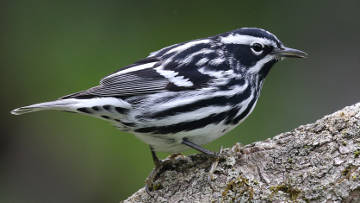Village News

PHOTO COURTESY OF GARRY KESSLER
A male black-and-white warbler. Females look similar but without black on their cheeks and throat.
May 29, 2020, Page A5
NATURE NOTES
By Annie Reid
Westborough Community Land Trust
A warbler that comes in black and white
May is warbler month. We think of warblers as hard to see and as colorful, active, insect-eating singers that flit about in the treetops, but they also come in black and white.
The aptly named black-and-white warblers (Mniotilta varia) are not your stereotypical warblers in ways other than their color scheme. Most notably, they can actually be relatively easy to see. They’re warblers that you don’t have to give yourself an uncomfortable case of “warbler neck” from looking upward to spot them. Like other warblers, black-and-white warblers forage for insects, but they’re usually busily traveling the tree trunks and branches, foraging on bark, instead of searching the treetops. You might see them at eye level or somewhat above.
If you’re used to noticing a bird moving head-first down a tree trunk and realizing that it’s a white-breasted nuthatch (Sitta canadensis), guess what? You have a transferable birding skill. Black-and-white warblers do the same thing. Take a careful look at a bird heading down a trunk at this time of year and you might see the vivid black and white stripes of this warbler. Both male and female have contrasting black and white stripes, but males have black throats and cheeks while females are white there.
Warblers are noted for their songs – musical trills, warbles, and more – which help us locate them and tell who’s who among them. But black-and-whites (as they’re known for short) sing a distinctive high-pitched song (“weesee-weesee-weesee”) that might remind you of a squeaky old gate rather than music.
Because we think of warblers as birds of the treetops, you might expect them to nest up there – and some do, but some don’t. Black-and-whites are among those that nest on the ground. They build nests with dry leaves on the outside and dry grass inside, often hidden against the base of a tree or a log or rock. They breed in our area but many that we see at this time of year are headed farther north, even into Canada.
Do other warblers come in black and white? One that passes through our area wears black and white but only for the breeding season: the blackpoll warbler (Setophaga striata), named for the black cap worn by males and some females. Blackpolls frequent treetops and are bound for breeding grounds in northern Canada and Alaska. Their song is musical – like the faint tinkling of bells – but so high pitched that not everyone can hear it.
Do any colorful warblers nest in our area? Some do, perhaps more than you’d realize. Look for these warblers with yellow on them: yellow warblers in shrubbery near water; prairie warblers in powerline cuts; blue-wing warblers in overgrown abandoned fields; pine warblers in white pines; and common yellowthroats deep in large bushes in fields. For red, look for American redstart males with red patches and females with yellow patches, in trees with vines near water. Ovenbirds singing in the woods are tan with an orange crest.
Many of “our” warblers turn around and start heading south toward their wintering grounds as soon as they’re done breeding in July or August, so May-June is the time to keep an eye – and ear – out for them. Enjoy!